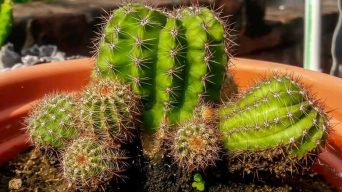Zz plants (Zamioculcas zamiifolia) are some of the most popular houseplants, for a good reason!
They’re easy to care for, beautiful, and a great addition to any home.
But like all plants, they can sometimes fall victim to root rot.
Although root rot is a severe problem, it can be easily fixed if you catch it early enough.
In this article, we’ll show you how to spot the signs of root rot in your Zz plant, and we’ll give you some tips on how to save your plant from this deadly disease.
What is Root Rot?
Root rot is a condition that can afflict many different types of plants, including the Zz plant.
It is caused by fungi or bacteria that attack the roots of the plant, causing them to rot.
When the roots rot, they can no longer absorb water and nutrients from the soil, which can eventually kill the plant.
What Causes Root Rot on ZZ Plants?
There are several different reasons why your Zz plant might develop root rot.
The most common causes of root rot are:
Overwatering
One of the most common reasons for root rot is overwatering.
If you water your Zz plant too often, or if you allow it to sit in water, this can cause the roots to rot.
When the roots are exposed to too much water, they can’t get the oxygen they need to function correctly, leading to root rot.
Overwatering can be caused by:
- Watering your plant too often
- Allowing your plant to sit in water
- Using a pot that doesn’t have proper drainage
Poor Drainage
If your pot doesn’t have proper drainage, this can also lead to root rot.
When you are using a pot without drainage, the water has nowhere to go, and it can start to pool at the bottom of the pot.
If this happens, your plant roots will sit in water for too long and start to rot.
If you are using a pot without drainage, it’s essential to ensure that you are carefully watering your plant so that the roots don’t sit in water for too long.
Using Soil that Retains Water
If you are using soil that retains water, this can also cause root rot.
Soil that retains water can be very dense and doesn’t allow the roots to breathe.
When the roots can’t breathe, they start to rot.
Using light, well-draining soil for your Zz plant is essential so the roots can get the oxygen they need.
Root Damage
If your plant’s roots are damaged, this can also lead to root rot.
Root damage can be caused by:
- Repotting your plant too often
- Using a pot that is too small
- Allowing your plant to dry out completely
When the roots are damaged, they are more susceptible to disease and can start to rot.
If you think your plant’s roots are damaged, it’s essential to take action immediately so that the root rot doesn’t have a chance to take hold.
Fungal Diseases
Fungal diseases can also cause root rot.
Wet, humid conditions often cause fungal diseases.
If your plant’s roots are constantly wet, this can create the perfect environment for fungi to grow.
Once the fungi start to grow, they can quickly spread and infect your plant’s roots, causing them to rot.
What Does ZZ Plant Root Rot Look Like?
You can look for several signs to determine if your Zz plant has root rot.
Some of the most common signs include:
Wilting
If your Zz plant is wilting, this is a sign that the roots are not getting the water they need.
When the roots are rotted, they can’t absorb water from the soil, and this can cause the plant to wilt.
Wilting can also be caused by other problems, such as drought or heat stress, so it’s essential to look for other signs of root rot before assuming this is the problem.
Yellow Leaves
If the leaves of your Zz plant are turning yellow, this is another sign that the roots are not getting the water they need.
Yellow leaves can also be caused by other problems, such as nutrient deficiencies, so it’s important to consider other factors.
Brown or Black Spots on the Leaves
If you see brown or black spots on the leaves of your Zz plant, this is a sign that the plant is suffering from a fungal disease.
Fungal diseases are often caused by wet, humid conditions, which is another sign that the roots might be rotted and your Zz plant may be dying.
Mushy or Soft Stems or Leaves
If the stems or leaves of your Zz plant are starting to feel mushy or soft, this is a sign that the plant is rotting.
When the plant is rotting, the stem and leaves will start to break down, and they will become mushy.
This is often one of the first signs that root rot takes hold of the plant.
Bad Smell
If your Zz plant starts to emit a bad smell, this is a sign that the plant is rotting.
When the plant is rotting, it will release a foul odor.
This is often one of the first signs that something is wrong with the plant.
Soggy Soil
If the soil around your Zz plant is constantly soggy or wet, this is a sign that the roots are sitting in water and they are starting to rot.
When the roots are exposed to too much moisture, they break down and rot.
This can often be prevented by ensuring that the soil around your plant is not too wet.
Slow Growth
If your Zz plant’s growth starts to slow down or stop, this is a sign that the roots are not getting the nutrients they need.
When the roots are rotted, they can’t absorb nutrients from the soil, and this can cause the plant to stop growing.
Mushy and Black Roots
If you notice that the roots of your Zz plant are mushy or soft, this is a sure sign that the plant has root rot.
When the roots rot, they will break down and become mushy.
This is often one of the first signs that something is wrong with the plant.
Collapsing Plant
If your Zz plant starts to collapse, this is a sign that the plant is severely damaged and is dying.
When the roots are rotted, they can’t support the plant, and this can cause the plant to start to collapse.
This often happens when the plant is too far gone, and nothing can be done to save it.
How To Treat ZZ Plant Root Rot
If you think your Zz plant has root rot, it’s essential to take action immediately.
Root rot can spread quickly and kill your plant if it’s not treated.
Here is a step-by-step guide on how to treat root rot:
1. Remove the plant from the pot and inspect the roots.
If the roots are black and mushy, this is a sure sign that the plant has root rot.
If the roots are still white and firm, this is a sign that the plant does not have root rot.
2. Remove as much soil as possible from the roots.
You want to remove as much of the infected soil as possible so that you can get to the healthy roots.
You can do this by gently washing the roots with water.
3. Cut away any black or mushy roots with a sharp knife.
Ensure to cut well below the affected area to remove all diseased roots.
Be careful not to damage the healthy roots.
You also need to make sure that you remove all of the affected leaves.
4. Clean the pot and your tools.
You need to make sure that you clean the pot thoroughly so that you don’t spread the infection.
You also need to clean your tools so that you don’t spread the infection to other plants.
5. Repot the plant in a fresh, sterile potting soil mix.
Make sure you use a fresh, sterile potting mix, so you don’t infect the plant.
Be careful not to damage the roots when you’re repotting the plant.
6. Water the plant carefully.
You need to be careful not to overwater the plant, so you don’t worsen the problem.
Water the plant until the soil is moist but not soggy.
7. Place the pot in a bright, warm location.
The plant needs to be in a bright, warm location, but you don’t want to place it in direct sunlight.
Direct sunlight can scorch the leaves and damage the plant.
7. Continue to monitor the plant and water as needed.
The plant will need time to recover, and it may take several weeks to start showing new growth.
Be patient and continue to care for the plant as directed.
How To Prevent ZZ Plant Root Rot
The best way to prevent root rot is to ensure that the plant receives the proper care.
Here are some tips on how to care for your Zz plant:
1. Water the Plant Properly
ZZ plants need to be watered about once a week or when the soil is dry to the touch.
Overwatering can lead to root rot, so ensure you are not watering too often.
2. Provide Good Drainage
ZZ plants need well-draining soil to thrive. If your plant is in a pot, ensure drainage holes are in the bottom.
You can also add gravel or rocks to the bottom of the pot to help with drainage.
3. Use a Well-Draining Potting Mix
Use a well-drained potting soil mix when potting or repotting your Zz plant.
A soil mix that is too dense can hold too much water and lead to root rot.
4. Repot in Fresh Soil Every Year or Two
It is a good idea to repot your Zz plant every year or two in fresh potting soil.
This will help to keep the plant healthy and prevent root rot.
5. Avoid Overcrowding
When potting your Zz plant, make sure not to overcrowd the roots.
This can lead to poor drainage and an increased risk of root rot.
6. Prune Dead or Damaged Roots
If you notice that any roots are dead or damaged, you should prune them off.
Dead roots can decay and spread rot to the healthy roots.
7. Place the Plant in a Bright Indirect Light
ZZ plants do best in bright indirect light. They can tolerate some direct sun, but too much sun can scorch the leaves.
If your plant is getting too much direct sun, you may notice the leaves start to turn yellow.
8. Check for Fungus Gnats
Fungus gnats are small flies that are attracted to damp conditions.
They can lay their eggs in the soil, and the larvae can feed on plant roots.
If you suspect your plant has fungus gnats, you should check the soil for tiny flies or larvae.
You can also try to trap the adult flies with yellow sticky traps.
9. Use Fertilizers Sparingly
It is best to use fertilizers sparingly on Zz plants.
Over-fertilizing can lead to root burn, damaging the roots and making them more susceptible to rot.
If you need to fertilize your plant, you should only use a half-strength fertilizer solution.
10. Avoid Soggy Soil
Ensure that the soil around your Zz plant is not soggy or wet.
Waterlogged soil can lead to root rot, so it is essential to ensure the plant has good drainage.
Final Thoughts
ZZ plant root rot is a severe problem that can kill your plant if left untreated.
However, following the proper care instructions and taking action quickly can save your plant from this fate.
Be sure to keep an eye out for the early signs of root rot so that you can take action immediately.
With the proper care, your Zz plant can thrive for many years.







